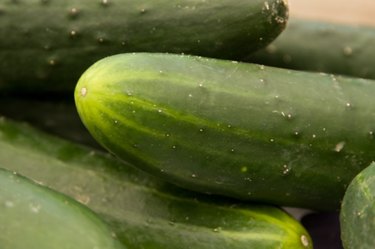
Cucumber plants (Cucumis sativus) are warm-season crops that are often eaten raw in salads or pickled. Cucumber vines require plenty of room to grow, and the plants thrive in full sun and well-drained soil. However, they are not problem-free, so if your cucumber leaves are turning white, take steps to diagnose and treat the problem right away. Some common causes of cucumber plants turning white include powdery mildew infection, leafhopper pest infestations and sunscald.
Cucumber Leaves Turning White
Video of the Day
Powdery mildew is a fungal disease, and the main symptom is white powdery fungal growth on the plant leaves. The infection starts as smaller spots but can spread to cover the entire leaf. Other symptoms you will see in more severe cases include fewer and smaller fruits and the general weakening of the plant.
Video of the Day
The disease spreads easily on the wind when the weather is hot and dry. Prevent infections by ensuring that plants are properly spaced and the garden is free of weeds. If the vines are crowded, consider staking them to allow for more airflow around the leaves. Make sure cucumbers are planted in full sun, as shady conditions can increase the risk of disease.
Excess fertilizer is another factor that contributes to powdery mildew growth. Conduct a soil test to determine the fertilizer needs for your plants. If powdery mildew has been a problem in your garden in the past, consider applying a fungicide to prevent future infections. Be sure the product is labeled for use on vegetables, such as cucumber plants, and follow all package instructions and warnings.
Pest Problems on Cucumbers
Leafhopper infestations may also be a cause of your cucumber leaves turning white. Typically, when there is damage from leafhoppers, the leaves aren't entirely white. Rather, the leaves are yellow with white stippling. Leaves may fall from the plant, and the infestation can decrease the amount and quality of fruits produced.
In addition to observing the damage, you can see leafhoppers on the bottom of the leaves. These pests are light green in color and are very small, which makes them difficult to see if you aren't looking for them. It takes a heavy infestation to cause serious problems for your plant.
Make sure your plants are receiving proper care and irrigation and remove dead plant material, where pests can breed. Row covers can be helpful but should be removed before the cucumber plant blooms so that the flowers can be pollinated and produce fruit.
Cucumber Cultural Concerns
There are also some cultural problems that can cause discoloration of your cucumber plant. Iron chlorosis typically presents itself as yellowing of the leaves. In severe cases, leaves may turn a very pale yellow and even appear white. Iron deficiency is not typically caused by a lack of iron in the soil but rather high soil pH levels that prevent plant roots from absorbing the iron.
If you suspect your plant is suffering from iron chlorosis, get a soil test and amend the soil to correct the pH based on the results. Ideally, this testing should be done every three years before you plant.
Leaf scorch may occur during hot, windy and dry conditions and may cause leaves to turn pale, yellow or brown. Make sure the plant is not water-stressed and don't remove damaged leaves, as this can expose the tender fruit below and result in photooxidative sunscald. The affected parts of the fruit will turn white. You can eat unaffected parts of the cucumber if it is ripe; otherwise, you should discard the entire fruit.
- University of Minnesota Extension: Powdery Mildew of Cucurbits
- University of Maryland Extension: Nutrient Deficiency of Vegetable Plants
- South Dakota State University Extension: Leaf Scorch and Sunscald in the Garden
- University of California Statewide Integrated Pest Management Program: Cucurbits, Leafhoppers